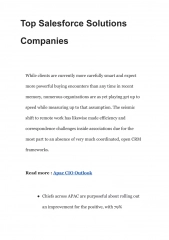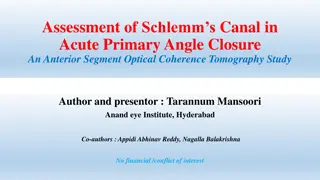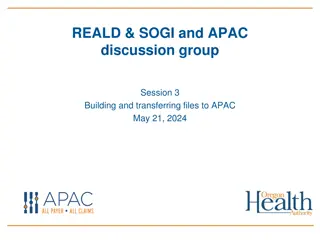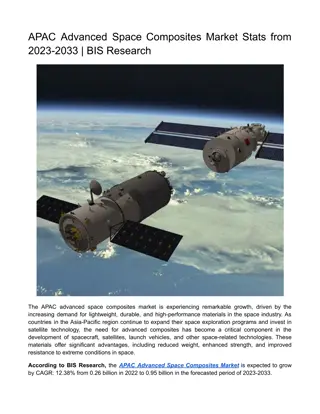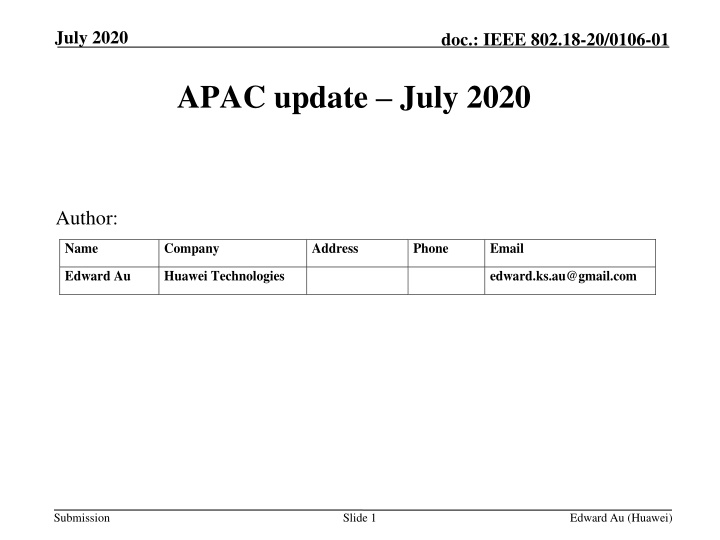
IEEE 802.18-20 APAC Updates on 5 GHz and 6 GHz Frequency Allocation in July 2020
Discover the latest activities in APAC relating to Wi-Fi and WPAN between May and July 2020. Explore consultations and proposed changes by Korea MSIT for enhancing data services and promoting 5G technologies in the 6 GHz band. Get insights into frequency bands, low-power wireless access systems, and more in this comprehensive update document.
Download Presentation

Please find below an Image/Link to download the presentation.
The content on the website is provided AS IS for your information and personal use only. It may not be sold, licensed, or shared on other websites without obtaining consent from the author. If you encounter any issues during the download, it is possible that the publisher has removed the file from their server.
You are allowed to download the files provided on this website for personal or commercial use, subject to the condition that they are used lawfully. All files are the property of their respective owners.
The content on the website is provided AS IS for your information and personal use only. It may not be sold, licensed, or shared on other websites without obtaining consent from the author.
E N D
Presentation Transcript
July 2020 doc.: IEEE 802.18-20/0106-01 APAC update July 2020 Author: Name Company Address Phone Email Edward Au Huawei Technologies edward.ks.au@gmail.com Submission Slide 1 Edward Au (Huawei)
July 2020 doc.: IEEE 802.18-20/0106-01 Background This slide deck provides a high-level overview of the activities in APAC (related to Wi-Fi and WPAN) between May and July 2020. Submission Slide 2 Edward Au (Huawei)
July 2020 doc.: IEEE 802.18-20/0106-01 Korea MSIT Consultation on Revision of the Table of Frequency Allocation on 5 GHz and 6 GHz Comments due on August 24, 2020. For details: http://english.msip.go.kr/web/msipContents/contentsView.do?cateId =_law4&artId=2942267 Motivation: To enable high-quality data service and accelerate the adoption of 5G convergence services using 5G-class unlicensed technology (e.g, WiFi 6E, 5G NR-U) in the 6 GHz band. Proposed change: Allow specific low-power wireless access systems including wireless LAN to be operated in the 5725-5850 MHz and 5925-712 MHz frequency bands by amending K37E in the Table of Frequency Allocation. Submission Slide 3 Edward Au (Huawei)
July 2020 doc.: IEEE 802.18-20/0106-01 Korea MSIT Frequency band Usage 5725-5850 MHz Fixed, Wireless detection, Mobile 5.150 5.453 Low power wireless data communication system K37F Object detection sensor K40A Low power wireless access system including wireless LAN K37E 5925-6700 MHz Fixed Fixed satellite (Earth to Space)(Space to Earth) 5.441 5.458B Broadcasting K151 Fixed microwave relay K151A UWB K125B Low power wireless access system including wireless LAN K37E K151D 7075-7190 MHz Fixed Mobile Broadcasting K151 Fixed microwave relay K151A UWB K125B Low power wireless access system including wireless LAN K37E K151D Submission Slide 4 Edward Au (Huawei)
July 2020 doc.: IEEE 802.18-20/0106-01 Korea MSIT Consultation on Revision of the Table of Frequency Allocation on 5 GHz and 6 GHz (cont d) Proposed change to K37E: The frequency bands of 5150 to 5350 MHz, 5470 to 5850 MHz and 5925 to 7125 MHz are used as low power wireless devices (for wireless access systems (WAS) including wireless LANs) and apply frequency sharing technology according to the relevant ITU-R recommendations. Submission Slide 5 Edward Au (Huawei)
July 2020 doc.: IEEE 802.18-20/0106-01 Korea MSIT Consultation on revised technical standards for radio equipment in 5 GHz and 6 GHz bands Comments due on August 24, 2020. For details: http://english.msip.go.kr/web/msipContents/contentsView.do?cateId =_law4&artId=2942268 Motivation: To enable high-quality data service and accelerate the adoption of 5G convergence services using 5G-class unlicensed technology (e.g, WiFi 6E, 5G NR-U) in the 6 GHz band. NOTE the same motivation as the previous consultation. Submission Slide 6 Edward Au (Huawei)
July 2020 doc.: IEEE 802.18-20/0106-01 Korea MSIT For radio equipment in 5925-6425 MHz: Occupied frequency bandwidth Power density including absolute antenna gain Remarks 0.5 MHz min 20 MHz max 1 dBm/MHz or less The power density including the absolute gain of the antenna should be an average value Drones are prohibited. Built-in wireless devices used in automobiles are allowed to operate in 6085-6425 MHz. 20 MHz min 40 MHz max -2 dBm/MHz or less 40 MHz min 80 MHz max -5 dBm/MHz or less 80 MHz min 160 MHz max -8 dBm/MHz or less Submission Slide 7 Edward Au (Huawei)
July 2020 doc.: IEEE 802.18-20/0106-01 Korea MSIT For indoor wireless devices in 5925-7125 MHz: Occupied frequency bandwidth Power density including absolute antenna gain Remarks 160 MHz 2 dBm/MHz or less The power density including the absolute gain of the antenna should be an average value Limited to equipment that is installed and operated by being connected to the power in the building or connected to another equipment. Prohibited use in vehicles such as automobiles, aircraft, railroads, ships, and drones Submission Slide 8 Edward Au (Huawei)
July 2020 doc.: IEEE 802.18-20/0106-01 Korea MSIT New conditions: Frequency tolerance deviation should be within 20 10-6. Out-of-band emission should have an average power density of 27 dBm/MHz or less, including the absolute antenna gain. For peak value, it should be less than -34 dBm/MHz at a frequency outside the 5925-6425 MHz band. Modulation type should be digital. Listen before talk should be used. Submission Slide 9 Edward Au (Huawei)
July 2020 doc.: IEEE 802.18-20/0106-01 Taiwan MOTC Consultation on considering 5925 7125 MHz as harmonized shared frequency bands Comments due on August 7, 2020. For details: https://www.motc.gov.tw/ch/home.jsp?id=15&parentpath=0,2&mcu stomize=multimessages_view.jsp&dataserno=202006180001&aplist dn=ou=data,ou=bulletin,ou=chinese,ou=ap_root,o=motc,c=tw&tools flag=Y&imgfolder=img%2Fstand Submission Slide 10 Edward Au (Huawei)
July 2020 doc.: IEEE 802.18-20/0106-01 Taiwan MOTC Part 1: Wi-Fi 6E or 5G NR-U related spectrum planning, technology and wireless network equipment, chipset and terminal product development roadmap 1. What is the current status of international Wi-Fi 6E or 5G NR-U related technical standards? What is the spectrum planning roadmap of major countries in the world? 2. What is the development status of Wi-Fi 6E related wireless network equipment, communication chips and terminal products at home and abroad? 3. What is the development status of 5G NR-U LAA and Standalone technology related wireless network equipment (or base station equipment), communication chips and terminal products at home and abroad? 4. What is the estimated time for major global manufacturers to have a mass production on Wi-Fi 6E and 5G NR-U related wireless network equipment and terminal products, or to list them as standard functions of their products? Submission Slide 11 Edward Au (Huawei)
July 2020 doc.: IEEE 802.18-20/0106-01 Taiwan MOTC Part 2: Considering there is only a company using some of the 5925- 6425 MHz bands while there are multiple companies using majority of the 6425-7125 MHz bands, if these bands are opened as a harmonious shared frequency band in the future, it should avoid signal interference to existing stations. 5. If 5925-7125 MHz is opened as a harmonious shared frequency band, what is the impact of the interference of Wi-Fi 6E and 5G NR-U on existing microwave relay stations? Is it necessary to conduct interference testing first? What is the reference basis? 6. Can the entire 5925-7125 MHz be open or should only part of the frequency band be open for sharing? If it is recommended to open only part of the frequency band, what is the frequency range? What is the reference basis? 7. Should 5925-7125MHz be restricted to indoor use only, limited to the geographic distance from existing radio stations, or specified with other interference protection mechanisms? What is the reference basis? Submission Slide 12 Edward Au (Huawei)
July 2020 doc.: IEEE 802.18-20/0106-01 Taiwan MOTC Part 2: Considering there is only a company using some of the 5925- 6425 MHz bands while there are multiple companies using majority of the 6425-7125 MHz bands, if these bands are opened as a harmonious shared frequency band in the future, it should avoid signal interference to existing stations. (Cont d) 8. If 5925-7125 MHz is open for harmonious sharing, what are the individual transmit power limits of its equipment and products? What is its reference basis? 9. Are there other recommended restrictions for opening 5925-7125 MHz as a harmonious shared frequency band? What is its reference basis? Submission Slide 13 Edward Au (Huawei)
July 2020 doc.: IEEE 802.18-20/0106-01 Taiwan MOTC Part 3: The MOTC is expected to include 5925-7125 MHz in the draft amendment Radio Frequency Supply Plan (hereinafter referred to as the Frequency Supply Plan) as a basis for the harmonious sharing of frequency bands. 10. What is your suggestion on the name of the proposed use of 5925-7125MHz? What are the reasons? 11. Can the telecom operators start the certification of related equipment and products and circulate freely in the market after obtaining certification after the draft amendment is announced? Or can they only carry out related equipment and product development and verification test before mass production in the factory? What are the reasons? 12. In addition, if the certification of related equipment and products cannot be carried out after the announcement, are there any other suggested open practices? What are the reasons? 13. If the frequency supply plan specifies 5925-7125 MHz as a harmonious shared frequency band, are there any other contents or remarks that are stated together? What are the reasons? Slide 14 Submission Edward Au (Huawei)
July 2020 doc.: IEEE 802.18-20/0106-01 Taiwan MOTC Part 4: Others. 14. Are there any other suggestions for opening the 5925-7125MHz as a harmonious shared frequency band? Submission Slide 15 Edward Au (Huawei)

